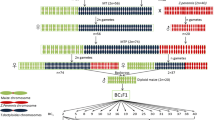Abstract
The expression of gene(s) governing apomictic reproduction inTripsacum provides the best foundation for comparing the effectiveness of apomictic reproduction in a series of maize-Tripsacum hybrids. Several 38-chromosome, apomictic maize-Tripsacum hybrids are available which possess the gene(s) conferring apomictic reproduction fromTripsacum. Without a base line for comparison, studies directed towards discerning the successful transfer or effectiveness of gene expression in a maize background are hampered. The objectives of this study are to compare the reproductive features found in apomicticTripsacum with those in apomictic maize-Tripsacum hybrids. In addition, this study determined the feasibility of utilizing these maize-Tripsacum hybrid materials to continue an attempt to transfer the genes into a pure maize background. The frequency and occurrence of five unique reproductive features found in apomictic accessions ofTripsacum dactyloides were compared to the reproductive behaviours exhibited in the maize-Tripsacum hybrids. Results indicate the genes controlling apomixis in tetraploidTripsacum are fully functional in maize-Tripsacum hybrids with diploid and triploid maize constitutions. The ability of theTripsacum apomictic genes to retain full expression provides evidence to continue their transfer to a diploid or tetraploid maize background.
Similar content being viewed by others
References
Asker, S.E. & L. Jerling, 1992. Apomixis in Plants. 1st Edition. CRC Press, Boca Raton, FL.
Bashaw, E.C. & W.W. Hanna, 1990. Apomictic Reproduction. p. 100–130. In G.P. Chapman (ed.), Reproductive Versatility in the Grasses. Cambridge University Press, Melbourne, Australia.
Bashaw, E.C., M.A. Hussey & K.W. Hignight, 1992. Hybridization (N+N and 2N+N) of facultative apomictic species in thePennisetum agamic complex. Int. J. Plant. Sci. 153: 466–470.
Brown, W.V. & W.H.P. Emery, 1958. Apomixis in the Gramineae: Panicoideae. Am. J. Bot. 45: 253–263.
Burson, B.L., P.W. Voigt, R.A. Sherman & C.L. Dewald, 1990. Apomixis and sexuality in eastern gamagrass. Crop Sci. 30: 86–89.
Burson, B.L., 1992. Cytology and reproductive behaviour of hybrids betweenPaspalum urvillei and two hexapoidP. dilatatum biotypes. Genome 35: 1002–1006.
Farquharson, L.I., 1954. Natural selection of tetraploids in a mixed colonly ofTripsacum dactyloides. Proc. Indiana Acad. Sci. 63: 80–82.
Farquharson, L.I., 1955. Apomixis and polyembryony inTripsacum dactyloides. Am. J. Bot. 42: 737–743.
Kermicle, J.L., 1969. Audrogenesis conditioned by a mutation in maize. Sci. 166: 1422–1424.
Kindiger, B. & S. Hamann, 1993. Generation of haploids in maize: A modification of the indeterminate gameophyte (ig) system. Crop Sci. 33: 324–344.
Kindiger, B., 1993. A technique for the preparation of somatic chromosomes of maize. p. 481–483. In M. Freeling and V. Walbot (eds.), The Maize Handbook. 1st Edition. Springer-Verlag, New York, Inc.
Kindiger, B. & C.L. Dewald, 1994. Genome accumulation in eastern gamagrass,Tripsacum dactyloides (L.) L. (Poaceae). Genetica 92: 197–201.
Kindiger, B. & V. Sokolov, 1995. Occurrence of partial meiotic behaviors in apomictic eastern gamagrass. p. 24. In: 37th Annual Maize Genetics Conference (Abstracts), Ed. B. Sheridan, Asilomar Conference Center, Pacific Grove, CA, March 16–19, 1995.
Kindiger, B., V. Sokolov & I.V. Khatypova, 1995. Evaluation of apomictic reproduction in a set of 38 chromosome maize-Tripsacum backcross hybrids. Crop Sci. (in press).
Koltunow, A.M., 1993. Apomixis: Embryo sacs and embryos formed without melosis or fertilization of ovules. The Plant Cell 5: 1425–1437.
Leblane, O., M.D. Peel, J.G. Carman & Y. Savidan, 1995. Megasporogenesis and megagametogenesis in severalTripsacum species (Poaceae). Am. J. Bot. 82: 57–63.
Petrov, D.F., 1957. Znachenie apomiksisa alya azkrepleniya geterozisa. Dokl. Akad. Nauk. USSR 112: 954–957.
Petrov, D.F., 1984. Apomixis and its Role in Evolution and Breeding. 1st Ed. Oxonian Press Pvt. Ltd., New Delhi, India.
Saghai-Maroof, M.A., K.M. Soliman, R.A. Jorgensen & R.W. Allard, 1984. Ribosomal DNA spacer-length polymorphisms in barley: Mendelian inheritance, chromosomal location and population dynamics. P.N.A.S. USA 81: 8014–8018.
Sherman, R.A., P.W. Voigt & R.L. Burson, 1991. Apomixis in diploid x triploidTripsacum dactyloides hybrids. Genome 34: 528–532.
Sokolov, V., B. Kindiger, C. Dewald & I.V. Khatypova, 1995. Comparative analysis of apomietie development in maize-Tripsacum hybrids andTripsacum dactyloides. Proc. Rus. Acad. Sci. (In press).
Stuber, C.W., J.F. Wendel, M.M. Goodman & J.S.C. Smith, 1988. Techniques and scoring procedures for starch gel electrophoresis of enzymes from maize (Zea mays L.). Technical Bull. 286, North Carolina Agric. Res. Serv., North Carolina State University, Raleigh, NC.
Williams, J.G.K., A.R. Kubelik, K.J. Livbak, J.A. Rafalski & S.V. Tingey, 1990. DNA polymorphisms amplified by arbitrary primers are useful as genetic markers. Nucleic Acids Res. 18: 6531–6535.
Wilson, K.J. & R.A. Jefferson, 1992. Preface. In K.J. Wilson (ed.), Proceedings of the International Workshop on Apemixis in Rice, Changsha, People's Republic of China. 13 Jan.–15 Jan. 1992. Human Hybrid Rice Research Center, Changsha, People's Republic of China.
Author information
Authors and Affiliations
Additional information
The use of company names in this publication does not imply endorsement by the USDA-ARS, or the product names or criticism of similar ones not mentioned. All programs and services of the U.S. Department of Agriculture are offered on a nondiscriminatory basis without regard to race, color, national origin, religion, sex, age, marital status, or handicap.
Rights and permissions
About this article
Cite this article
Kindiger, B., Sokolov, V. & Dewald, C. A comparison of apomictic reproduction in eastern gamagrass (Tripsacum dactyloides (L.) L.) and maize-Tripsacum hybrids. Genetica 97, 103–110 (1996). https://doi.org/10.1007/BF00132586
Received:
Accepted:
Issue Date:
DOI: https://doi.org/10.1007/BF00132586




